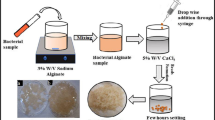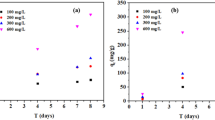Abstract
In this study, the degradation of tetradecyltrimethylammonium bromide (TTAB) by freely suspended and alginate-entrapped cells from the bacteria Pseudomonas putida (P. putida) A ATCC 12633 was investigated in batch cultures. The optimal conditions to prepare beads for achieving a higher TTAB degradation rate were investigated by changing the concentration of sodium alginate, pH, temperature, agitation rate and initial concentration of TTAB. The results show that the optimal embedding conditions of calcium alginate beads are 4 % w/v of sodium alginate content and 2 × 108 cfu ml−1 of P. putida A ATCC 12633 cells that had been previously grown in rich medium. The optimal degradation process was carried out in pH 7.4 buffered medium at 30 °C on a rotary shaker at 100 rpm. After 48 h of incubation, the free cells degraded 26 mg l−1 of TTAB from an initial concentration of 50 mg l−1 TTAB. When the initial TTAB concentration was increased to 100 mg l−1, the free cells lost their degrading activity and were no longer viable. In contrast, when the cells were immobilized on alginate, they degraded 75 % of the TTAB after 24 h of incubation from an initial concentration of 330 mg l−1 of TTAB. The immobilized cells can be stored at 4 °C for 25 days without loss of viability and can be reused without losing degrading capacity for three cycles.





Similar content being viewed by others
References
Arvind S, Sunil K (2011) Mercury bioremediation by mercury accumulating Enterobacter sp. cells and its alginate immobilized application. Biodegradation 23:25–34
Bradford M (1976) A rapid and sensitive method for the quantitation of microgram quantities of protein utilizing the principle of protein-dye binding. Anal Biochem 72:248–254
Cassidy MB, Lee H, Trevors JT (1996) Environmental applications of immobilized microbial cells: a review. J Ind Microbiol 16:79–101
Chan WC, Lai TY (2010) Interaction of compounds on biodegradation of ketone mixtures in a biofilter. J Chem Technol Biotechnol 85:416–422
Chen YM, Lin TF, Huang C, Lin JC, Hsieh FM (2007) Degradation of phenol and TCE using suspended and chitosan- immobilized Pseudomonas putida. J Hazard Mater 148:660–670
Covarrubias SA, de Bashan LE, Moreno M, Bashan Y (2011) Alginate beads provide a beneficial physical barrier against native microorganisms in wastewater treated with immobilized bacteria and microalgae. Appl Microbiol Biotechnol 93:2669–2680
Cross JT (1970) A critical review of techniques for the identification and determination of cationic surfactants. In: Jungermann E (ed) Cationic surfactants. Marcel Dekker, New York, pp 423–449
Cross JT (1994) Introduction to cationic surfactants. In: Jungermann E (ed) Cationic surfactants. Marcel Dekker, New York, pp 6–15
Duque E, García V, de la Torre J, Godoy P, Bernal P, Ramos JL (2004) Plasmolysis induced by toluene in a cyoB mutant of Pseudomonas putida. Environ Microbiol 10:1021–1031
Fernández P, Alder AC, Suter MJF, Giger W (1996) Determination of the quaternary ammonium surfactant ditallowdimethylammonium in digested sludges and marine sediments by supercritical fluid extraction and liquid chromatography with postcolumn ion-pair formation. Anal Chem 68:921–929
Gentili AR, Cubitto MA, Ferrero M, Rodriguez MS (2006) Bioremediation of crude oil polluted seawater by a hydrocarbondegrading bacterial strain immobilized on chitin and chitosan flakes. Int Biodeterior Biodegrad 57:222–228
Gilbert P, Moore LE (2005) Cationic antiseptics: diversity of action under a common epithet. J Appl Microbiol 99:703–715
Gouda MK (2007) Immobilization of Rhodococcus sp. DG for efficient degradation of phenol. Fresen Environ Bull 16:1655–1661
Ha J, Engler CR, Wild JR (2009) Biodegradation of coumaphos, chlorferon, and diethylthiophosphate using bacteria immobilized in Ca-alginate gel beads. Bioresour Technol 100:1138–1142
Hall DO, Rao KK (1989) Immobilized photosynthetic membranes and cells for the production of fuels and chemicals. Chim Oggi 1:41–47
Kaech A, Hofer M, Rentsch D, Schnider C, Egli T (2005) Metabolites and dead-end products from the microbial oxidation of quaternary ammonium alcohols. Biodegradation 16:461–473
Kanasawud P, Hjorleifsdottir S, Holst O, Mattiasson B (1989) Studies on immobilization of the thermophilic bacterium Thermus aquaticus YT-1 by entrapment in various matrices. Appl Microbiol Biotechnol 31:228–233
Kewellow H, Heipieper HJ, Rehm HJ (1989) Protection of bacteria against toxicity of phenol by immobilization in calcium alginate. Appl Microbiol Biotechnol 31:283–389
Kroon AGM, van Ginkel CG (2001) Complete mineralization of dodecyldimethylamine using a two-membered bacterial culture. Environ Microbiol 3:131–136
Liffourrena AS (2010) Physiological, biochemical and molecular bases of degradation synthetic quaternary ammonium salts by Pseudomonas putida. Thesis, Universidad Nacional de Río Cuarto, Río Cuarto
Liffourrena AS, López FG, Salvano MA, Domenech CE, Lucchesi GI (2008) Degradation of tetradecyltrimethylammonium by Pseudomonas putida A ATCC 12633 restricted by accumulation of trimethylamine is alleviated by addition of Al+3 ions. J Appl Microbiol 104:396–402
Liffourrena AS, Boeris PS, Salvano MA, Lucchesi GI (2009) A fluorescence assay for tetradecyltrimethylammonium mono-oxygenase activity that catalyzes the cleavage of the C–N bond with the production of trimethylamine. Anal Biochem 384:343–347
Liffourrena AS, Salvano MA, Lucchesi GI (2010) Pseudomonas putida A ATCC 12633 oxidizes trimethylamine aerobically via two different pathways. Arch Microbiol 192:471–476
Liu YJ, Zhang AN, Wang XC (2009) Biodegradation of phenol by using free and immobilized cells of Acinetobacter sp. XA05 and Sphingomonas sp. FG03. Biochem Eng J 44:187–192
Lu D, Zhang Y, Niu S, Wang L, Lin S, Wang C, Ye W, Yan C (2012) Study of phenol biodegradation using Bacillus amyloliquefaciens strain WJDB-1 immobilized in alginate–chitosan–alginate (ACA) microcapsules by electrochemical method. Biodegradation 23:209–219
Lucchesi GI, Liffourrena AS, Boeris PS, Salvano MA (2010) Adaptative response and degradation of quaternary ammonium compounds by Pseudomonas putida A ATCC 12633. In: Méndez-Vilas A (ed) Current research, technology and education topics in applied microbiology and microbial biotechnology. Formatex, Badajoz, pp 1297–1303
Macdonnell G, Russell AD (1999) Antiseptics and disinfectants: activity, action, and resistance. Clin Microbiol Rev 12:47–179
Mamo G, Gessesse A (1997) Thermostable amylase production by immobilized thermophilic Bacillus sp. Biotechnol Technol 11:447–450
Manohar S, Karegoudar TB (1998) Degradation of naphthalene by cells of Pseudomonas sp. strain NGK 1 immobilized in alginate, agar and polyacrylamide. Appl Microbiol Biotechnol 49:785–792
Moslemy P, Neufeld RJ, Guiot SR (2002) Biodegradation of gasoline by gellan gum-encapsulated bacterial cells. Biotechnol Bioeng 80:175–184
Nishihara T, Okamoto T, Nishiyama N (2000) Biodegradation of didecyldimethylammonium chloride by Pseudomonas fluorescens TN4 isolated from activated sludge. J Appl Microbiol 88:641–647
Nishiyama N, Toshima Y, Ikeda Y (1995) Biodegradation of alkyltrimethylammonium salts in activated sludge. Chemosphere 30:593–603
Quek E, Ting YP, Tan HM (2006) Rhodococcus sp. F92 immobilized on polyurethane foam shows ability to degrade various petroleum products. Bioresour Technol 97:32–38
Ravichandra P, Gopal M, Annapurna J (2008) Biological sulfide oxidation using autotrophic Thiobacillus sp.: evaluation of different immobilization methods and bioreactors. J Appl Microbiol 106:1280–1291
Sergio AMD, Bustos TY (2009) Biodegradation of wastewater pollutants by activated sludge encapsulated inside calcium-alginate beads in a tubular packed bed reactor. Biodegradation 20:709–715
Sossa Urrego D, Navarro Acevedo MA, Matiz Villamil A, Mercado Reyes M, Quevedo Hidalgo B, Pedroza Rodríguez A (2008) Immobilization of Bacillus licheniformis and Saccharomyces cerevisiae for ethanol production from potato starch. Universitas Scientiarum 13:149–161
Takenaka S, Tonoki T, Taira K, Murakami S, Aokil K (2007) Adaptation of Pseudomonas sp. Strain 7–6 to quaternary ammonium compounds and their degradation via dual pathways. Appl Environ Microbiol 73:1797–1802
Tallur PN, Megadi VB, Ninnekar HZ (2009) Biodegradation of p-cresol by immobilized cells of Bacillus sp. strain PHN 1. Biodegradation 20:79–83
Trevors JT, Van Elsas JD, Lee H, Van Overbeek LS (1992) Use of alginate and other carriers for encapsulation of microbial cells for use in soil. Microb Releases 1:61–69
van Ginkel CG (1991) Relations between the structure of quaternary alkyl ammonium salts and their biodegradability. Chemosphere 23:281–289
van Ginkel C, Pomper M, Stroo C, Kroon A (1995) Biodegradation of fatty amines: utilization of the alkyl chains by isolated microorganisms. Tenside Surfact Deterg 32:355–359
Wang X, Gong ZQ, Li PJ, Zhang LH, Hu XM (2008) Degradation of pyrene and benzo(a)pyrene in contaminated soil by immobilized fungi. Environ Eng Sci 25:677–684
Zhang K, Xu YY, Hua XF, Han HL, Wang JN, Wang J, Liu YM, Liu Z (2008) An intensified degradation of phenanthrene with macroporous alginate-lignin beads immobilized Phanerochaete chrysosporium. Biochem Eng J 41:251–257
Zhao T, Sun G (2007) Hydrophobicity and antimicrobial activities of quaternary pyridinium salts. J Appl Microbiol 104:824–830
Acknowledgments
GIL is Career Members of the Consejo Nacional de Investigaciones Científicas y Técnicas (CONICET). MFB is grateful for fellowships from CONICET-Ministerio de Ciencia y Tecnología de Córdoba. We thank Andrés Liffourrena and Gisel Esteves (Universidad Nacional Río Cuarto) for their collaboration in conducting experiments. This work was supported by Grants from CONICET, MCyT Córdoba and SECYT–UNRC of Argentina.
Author information
Authors and Affiliations
Corresponding author
Rights and permissions
About this article
Cite this article
Bergero, M.F., Lucchesi, G.I. Degradation of cationic surfactants using Pseudomonas putida A ATCC 12633 immobilized in calcium alginate beads. Biodegradation 24, 353–364 (2013). https://doi.org/10.1007/s10532-012-9592-3
Received:
Accepted:
Published:
Issue Date:
DOI: https://doi.org/10.1007/s10532-012-9592-3




